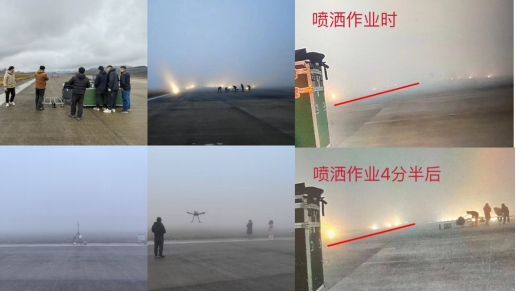On February 26, 2024, led by Xu Chenghua, Dean of the College of Resources and Environment at Chengdu University of Information Technology (CUIT), a team consisting of seven people, including Teacher Ren Hong and Teacher Wu Hao from the College of Resources and Environment and the College of Electronics, respectively, as well as graduate students from both colleges, embarked on a fog dispersal experiment using drones at Yuezhao Airport in Liupanshui, Guizhou. Participants from Yuezhao Airport, Guizhou Meteorological Bureau, the Second Research Institute of China Civil Aviation Administration, Xi'an Xiangyang Aerospace Materials Co., Ltd., and Shaanxi Zhongtian Rocket Technology Co., Ltd., totaled over 30 individuals.

The process and effect of drone-based fog dispersal operations at the airport
CUIT was responsible for the overall arrangement of the outdoor experiment, while Yuezhao Airport assisted with the airport-based testing. The Guizhou Meteorological Bureau and the Second Research Institute of China Civil Aviation Administration coordinated among the various units, and Xi'an Xiangyang Aerospace Materials Co., Ltd. and Shaanxi Zhongtian Rocket Technology Co., Ltd. were responsible for implementing the experiment.
On the morning of February 27, after a meeting at Yuezhao Airport in Liupanshui, the team discussed the division of labor, test areas, and operational routes. On February 27, using the Zhongtian Rocket TL-120 drone and the dry powder warm cloud catalyst independently developed by CUIT, a preliminary drone-based fog dispersal experiment was conducted to optimize the subsequent operational plan. On the morning of March 1, under suitable meteorological conditions, the team conducted another preliminary test to ensure the smooth progress of the experiment.
At 18:00 on March 1, with visibility at the airport below 300m, the drone loaded with catalyst began the official operation. The operational area was the middle section of the runway, with a flight altitude of 300m. Before the operation, the runway visibility (VIS) was 400m, and the runway visual range (RVR) was 350m. Within 10 minutes after the operation, the runway VIS increased to 1200m, and the RVR rose to 1500m, indicating a significant effect of the fog dispersal experiment.
